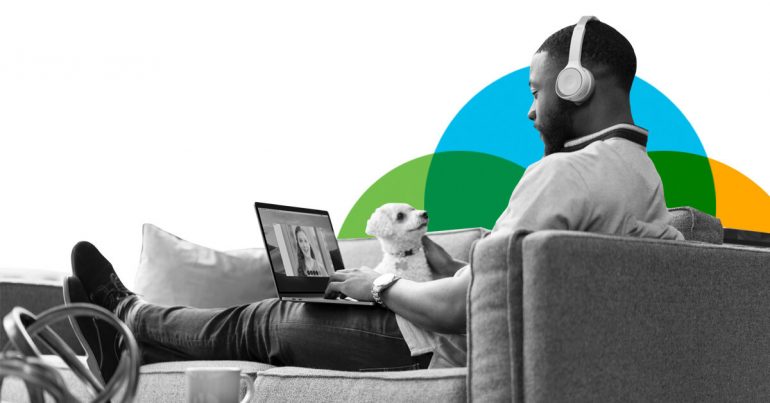The Cisco Designed Small Business Resiliency series shares stories and resources for businesses working to recover from the economic impact of COVID-19.
The COVID-19 pandemic pushed almost all businesses into some form of remote work. But as the pandemic continues, some companies have returned to offices, opted for a hybrid model, or officially chosen fully-remote as their path forward.
To better understand how startups are adapting to remote work during the pandemic, BetaKit spoke with four startups – Willful, Doxim, Soapbox, and Drop – to get their perspectives on a variety of different questions on the new ways of working for Canadian tech.
How do you define remote work in your organization?
 “To me, remote work means flexibility – the ability to define the parameters of how you work best, and to accommodate that across the organization.”
“To me, remote work means flexibility – the ability to define the parameters of how you work best, and to accommodate that across the organization.”
– Erin Bury, CEO, Willful
 “Giving everyone the ability to work where they’re most productive. The default accommodations for any work is remote-first or asynchronous.”
“Giving everyone the ability to work where they’re most productive. The default accommodations for any work is remote-first or asynchronous.”
– Brennan McEachran, CEO, Soapbox
 “We understand no two individuals have the same working style and that a change in scenery can spark creativity, allow for heads-down focus work, or simply support employees having a work-life balance. We encourage employees to find a schedule that is most productive for themselves and the teams they work most closely with.
“We understand no two individuals have the same working style and that a change in scenery can spark creativity, allow for heads-down focus work, or simply support employees having a work-life balance. We encourage employees to find a schedule that is most productive for themselves and the teams they work most closely with.
“What’s most important is that each person is accountable for making contributions and driving impact to our Company goals, whether that be from the office, from home, or the coffee shop down the street.”
– Paul Crowe, Chief Revenue Officer, Drop
What software / tools have you implemented to make remote work work at your company?
 “We surveyed our team early on in COVID, and more recently, about their mental health, their home office setups, and about their anxiety levels. Early in COVID, there were definitely higher anxiety levels because it was so new, and mental health was a top priority.
“We surveyed our team early on in COVID, and more recently, about their mental health, their home office setups, and about their anxiety levels. Early in COVID, there were definitely higher anxiety levels because it was so new, and mental health was a top priority.
“We gave folks an extra $500 for therapy or mindfulness/meditation expenses; we gave several paid days off as mental health days; and we tried to focus on helping with general anxiety reduction. Now, I think people are used to the uncertainty of COVID, and it’s more “business as usual,” but there’s a sense of anxiety around a long, dark, cold winter spent inside – especially for team members who are single, who lives in small spaces, or who can’t see their families.”
– Erin Bury, CEO, Willful
 “Outside of happy hours or social hours, one of the things we did was unplug sessions. We had a partner provide meditations and different short wellness sessions so Associates can learn various coping mechanisms.
“Outside of happy hours or social hours, one of the things we did was unplug sessions. We had a partner provide meditations and different short wellness sessions so Associates can learn various coping mechanisms.
“We also did no-meeting Friday afternoons to give folks time to wrap up their weeks and had wellness hours, which were 2-4 hour blocks of time that employees could book to help their kids with school work and start or end work at different times. It was about giving them the means and permission to put wellness practices in place.”
– Jenn Didine, Chief People Officer, Doxim
What was the biggest hurdle you needed to find a solution for when implementing remote work?
 “Our sales and marketing organization has changed in response to COVID. We were very much a face-to-face type of organization. Overnight, that went away. We not only shifted marketing from in-person at conferences to fully digital, but we changed the team to support it.”
“Our sales and marketing organization has changed in response to COVID. We were very much a face-to-face type of organization. Overnight, that went away. We not only shifted marketing from in-person at conferences to fully digital, but we changed the team to support it.”
– Janet Luisser, VP Marketing, Doxim
 “If we didn’t have regularly scheduled meetings, it would have been a lot harder to make the transition. So, it’s been less about the tools and more about our weekly cadences and how we distribute information. At Soapbox, this is how we’ve set up our syncs:
“If we didn’t have regularly scheduled meetings, it would have been a lot harder to make the transition. So, it’s been less about the tools and more about our weekly cadences and how we distribute information. At Soapbox, this is how we’ve set up our syncs:
- Company-wide town hall every Monday
- Company-wide demo day every other Friday
- One-on-ones at least once per month (cadence varies across every manager and employee)
- Team meetings at least once per sprint (2-week sprints)”
– Brennan McEachran, CEO, Soapbox
 “The biggest hurdle was keeping that visibility and connection company-wide. Some of the ways we have solved for this is by adapting our All Hands and Town Hall meetings to allow each department to give updates on impactful work and over-communicate our vision and plans.
“The biggest hurdle was keeping that visibility and connection company-wide. Some of the ways we have solved for this is by adapting our All Hands and Town Hall meetings to allow each department to give updates on impactful work and over-communicate our vision and plans.
“In addition to this, we also send an anonymous bi-weekly Pulse Check Survey for employees to complete which allows for a more holistic view on how we are operating during a remote time in the areas that matter most… Low ratings on any of these areas allow us to adjust accordingly in how we are operating.
“From an individual standpoint, we have incorporated more weekly virtual socials, such as Lunch Together, virtual coffees, Thursday night socials, game nights, movie nights, yoga, meditation etc. to allow for those personal and organic connections we miss when not in office.”
– Paul Crowe, Chief Revenue Officer, Drop

What was the employee response like at the start of the pandemic, and how do people feel now?
 “Beyond the transition, the start of the pandemic was definitely tough for the team. We had to go through a round of layoffs, stress and anxiety levels were high, and everyone was trying to make sense of what was going on in the world.
“Beyond the transition, the start of the pandemic was definitely tough for the team. We had to go through a round of layoffs, stress and anxiety levels were high, and everyone was trying to make sense of what was going on in the world.
“However, the team had the luxury of understanding that our work environment right now isn’t one that’s “normal” for remote work, considering that we’re all stuck at home all of the time. So, it didn’t put people off of wanting to be remote post-pandemic.”
– Brennan McEachran, CEO, Soapbox
 “It was clear in the beginning that employees were still finding their footing in how to best work remote daily. It then slowly shifted to investing in the right at-home setup and finding their rhythm and routines, and now it appears to be people have found their groove and are in a state of maintenance where they can constantly make minor adjustments while staying highly productive.”
“It was clear in the beginning that employees were still finding their footing in how to best work remote daily. It then slowly shifted to investing in the right at-home setup and finding their rhythm and routines, and now it appears to be people have found their groove and are in a state of maintenance where they can constantly make minor adjustments while staying highly productive.”
– Paul Crowe, Chief Revenue Officer, Drop
What do you find you do less now that you’re working remotely? More of?
 “We enhanced our internal communications and touchpoints with Associates. We’re more productive, but you can’t just wake up, log in, work until 6 pm, and do it all again. We’re doing more education on health, safety, and personal wellbeing so Associates can continue to work and stay healthy.”
“We enhanced our internal communications and touchpoints with Associates. We’re more productive, but you can’t just wake up, log in, work until 6 pm, and do it all again. We’re doing more education on health, safety, and personal wellbeing so Associates can continue to work and stay healthy.”
– Mike Rogalski, CEO, Doxim
 “We maintain, to this day, two mornings a week where the entire sales, marketing, and customer success organization gets together to socialize, have fun, and talk about work. We try not to make it all about work. We want people communicating and building relationships.”
“We maintain, to this day, two mornings a week where the entire sales, marketing, and customer success organization gets together to socialize, have fun, and talk about work. We try not to make it all about work. We want people communicating and building relationships.”
– Janet Luisser, VP Marketing, Doxim
 “We have more trust and understanding knowing that the work will still be completed. We are also seeing more laser-focused work as employees are focusing on what is most important with fewer distractions.”
“We have more trust and understanding knowing that the work will still be completed. We are also seeing more laser-focused work as employees are focusing on what is most important with fewer distractions.”
– Paul Crowe, Chief Revenue Officer, Drop
How did company-wide, or team-specific communication change with the move to remote work?
 “We started having comedians, musicians, virtual bingo, and motivational speakers join our team meetings. It’s not that we didn’t do this in the past, but it was geared towards larger events like sales kickoffs.”
“We started having comedians, musicians, virtual bingo, and motivational speakers join our team meetings. It’s not that we didn’t do this in the past, but it was geared towards larger events like sales kickoffs.”
– Mike Rogalski, CEO, Doxim
 “On the meeting side, nothing has changed, everything is just digital now. However, we’ve made a bigger push to use public channels in Slack as our default.”
“On the meeting side, nothing has changed, everything is just digital now. However, we’ve made a bigger push to use public channels in Slack as our default.”
– Brennan McEachran, CEO, Soapbox
 “We have adapted company-wide meetings to feature updates from all departments, highlight our company goals and progress towards them, and detailed metrics. In addition to this, departments also now send out weekly/biweekly emails to keep everyone well informed on what is happening across the organization.
“We have adapted company-wide meetings to feature updates from all departments, highlight our company goals and progress towards them, and detailed metrics. In addition to this, departments also now send out weekly/biweekly emails to keep everyone well informed on what is happening across the organization.
“Managers are encouraged to have more touchpoints with their teams directly to not only allow for visibility into daily operations, but to assist with any roadblocks or feedback in real time.”
– Paul Crowe, Chief Revenue Officer, Drop
What plans do you have for remote work going forward: hybrid, all-remote, or return to office?
 “We’ll take a hybrid approach. The goal is to offer flexibility, and give people the ability to define how they best work. Until COVID is not a daily worry though, we’ll be limiting the number of people in the office, and we don’t have a “return to office” date where everyone can comfortably work together in the space.”
“We’ll take a hybrid approach. The goal is to offer flexibility, and give people the ability to define how they best work. Until COVID is not a daily worry though, we’ll be limiting the number of people in the office, and we don’t have a “return to office” date where everyone can comfortably work together in the space.”
– Erin Bury, CEO, Willful
 “We’ll have three types of workers: people who need to work in person will come in every day. Hybrid associates may come in 2-3 days per week. And then we’ll have an all-remote workforce, primarily in our sales organization but also across the organization, that may only come in 1-2 times per month.”
“We’ll have three types of workers: people who need to work in person will come in every day. Hybrid associates may come in 2-3 days per week. And then we’ll have an all-remote workforce, primarily in our sales organization but also across the organization, that may only come in 1-2 times per month.”
– Jenn Didine, Chief People Officer, Doxim
 “We’re still in the process of figuring this out as a team. We’ve recently hired a few international employees across multiple time zones and continents, so we will definitely continue to run as a remote-first company.”
“We’re still in the process of figuring this out as a team. We’ve recently hired a few international employees across multiple time zones and continents, so we will definitely continue to run as a remote-first company.”
– Brennan McEachran, CEO, Soapbox
 “Drop has always embraced a hybrid work model and although we don’t have all the answers today, we know that our flexible Work-From-Home Policy will be even more flexible in future.”
“Drop has always embraced a hybrid work model and although we don’t have all the answers today, we know that our flexible Work-From-Home Policy will be even more flexible in future.”
– Paul Crowe, Chief Revenue Officer, Drop

